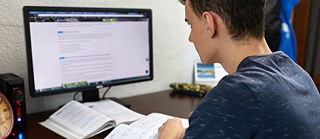Homework
So why does no-one actually talk about ... homework?

Homework still appears to be seen as the “poor relation” in foreign language lessons: everyone knows about it and uses it, but no-one wants to think seriously about it. And yet homework, especially when digitally supported, offers freedoms that can be used in a motivating and beneficial manner for foreign language acquisition.
Homework is an integral part of lessons in many contexts in which the learning of German as a foreign language is controlled by an institution: outside normal class hours, students continue learning by completing task-based activities. Most of the time, the tasks are set by the teachers, who also check the results.
Functions: why is repetitive practice given priority?
Homework in GFL lessons appears to have changed hardly at all in recent decades: admittedly, no small amount of homework is set regularly, yet it is frequently attributed no “concrete, significant, understandable and systematic status in the overall preparation, implementation and indeed subsequent analysis of lessons” (Standop 2013: 17). As a rule, teachers use homework as a follow-up to their lessons to ensure that learners practise and revise new content, that a transfer takes place or that something is applied productively.Only occasionally do teachers set homework in order to expand or supplement the lesson or to complete or deepen the learning process (Standop 2013: 50). However, this means that teachers are failing to exploit some valuable potential: homework can also be used in preparation for a lesson, for example to activate existing knowledge. This can make it easier for learners to understand texts they will hear or read in the next lesson. In addition, it can influence learner expectations such that they approach new content with greater motivation or acquire new insights of their own accord in advance.
One aspect closely associated with this is the possibility to use homework to (further) develop learner autonomy (Pauels 2003): homework after all is the one element of the lesson in which the learners’ abilities to control their own learning process are challenged to a greater extent by the external framework conditions alone than in many phases of classroom teaching. Learners are often left alone to cope with this demand (and the potential). There is thus an urgent need to think and talk more about how to use and design homework time in a way that makes sense.
Interlinking lessons and homework
Suggested methods of creating effective and motivating homework are based primarily on aspects relating to lesson organization. In this context, it is important not only to interlink lessons and homework, but also to give feedback.When teachers set homework only as a follow-up exercise and neither check that the homework has been done properly nor incorporate it into the subsequent lesson, the homework often acquires no real significance for the learners or for the lessons themselves. This increases the likelihood that the homework will be done only half-heartedly, or indeed not at all. If on the other hand homework is used to prepare for the next lesson, this automatically establishes a link. Thus learners can also be given more responsibility for the lesson and its success, for example by being asked to prepare lesson content not only for themselves but also for other learners. So as not to jeopardize lesson quality, learners need to be prepared for such autonomous work. To this end, the teacher should introduce helpful strategies during the lesson and practise these together with the learners (Aßbeck 1998: 374).

Feedback about homework
Empirical studies have shown among other things that learners who expect to be given relevant feedback will be more willing to do their homework. This is not only due to the fact that learners come to assume that their homework will be checked; it is also the case that appropriate feedback is often seen as an acknowledgement of the work they have done, and as proof that the teacher is interested in their results (Standop 2013: 275). In the interests of lifelong learning, learners should also be motivated to demand feedback or to organize it themselves.Motivating homework
It is not only aspects relating to lesson organization that play an important role in homework – social and emotional aspects do too. This includes learner motivation: in principle, for homework to motivate learners, the lesson must do likewise. Learner motivation can also be increased by the particular way in which homework is designed, however. Part and parcel of this involves ensuring that homework is designed according to the same principles as the lesson itself. If teachers use activity-oriented lessons, the homework should also encourage learners to actively use the language. Giving learners a choice of homework, or thinking together with them about which homework would make best sense, can also have positive effects (Pauels 2003).
More diverse homework thanks to digital media
The blended learning (i. e. a blend of online and face-to-face learning) approach is a good way of rethinking homework. It may prompt one to decide not only to use digital media for homework, but also to incorporate a blended approach on other levels too, thereby making homework – and the lessons themselves – more diverse (and effective). This is illustrated by three examples:Site of learning
Homework can be used to enable authentic communication and situation-based learning, for example through contact with speakers of the target language. Not only virtual spaces such as a foreign-language forum can be used for this, but also real places like the railway station in the learner’s hometown. Collaboration on a learning platform and the use of mobile devices allow learners to be set tasks at these sites, and may even enable them to obtain direct support and assistance.
Interaction and work forms
Although learners continue to be physically on their own when doing their homework, all kinds of new virtual constellations become possible. For example, social media can be used for collaborative homework activities (involving no great organizational effort). Audio and video chats, as well as collaborative text editors such as Wikis or Google Docs, make it possible to work together on texts or discuss content almost in real time. In their turn, teachers can also provide learning support during the homework phase: they may make themselves available for synchronous consultation at specific times, or may provide individual asynchronous feedback.
Individual learning
Homework is an ideal way of achieving differentiation. For example, teachers can give learners the freedom to choose – depending on their level and their preferences – the media format they want to use for a project task. A learning platform is again used in this context so as to make the results accessible to all and to enable peer feedback.
If one takes the time to look more closely at the area of homework in foreign language lessons, the potential that still remains untapped here quickly becomes clear. However, in many cases this requires a degree of rethinking on the part of both teachers and learners. Teachers should (also) design homework differently, allowing greater freedoms and also incorporating digital media. This may encourage learners to take more responsibility for the learning freedom that homework offers, and to help shape this scope of development themselves. If so, they will no longer view homework merely as a necessary evil.
Literature
Aßbeck, Johann (1998): Über die Funktion von Hausaufgaben. In: Jung, Udo O. H. (Ed.): Praktische Handreichungen für den Fremdsprachenlehrer. 2., verb. und erw. Aufl. (= Bayreuther Beiträge zur Glottodidaktik; 2). Frankfurt am Main: Peter Lang, p. 371-376.Pauels, Wolfgang (2003): Hausaufgaben. In: Bausch, Karl-Richard/Christ, Herbert/Krumm, Hans-Jürgen (Ed.): Handbuch Fremdsprachenunterricht. 4. Aufl.. Tübingen und Basel: Utb Francke, p. 317-320.
Standop, Jutta (2013): Hausaufgaben in der Schule. Theorie, Forschung, didaktische Konsequenzen. Bad Heilbrunn: Julius Klinkhardt.
Würffel, Nicola (2018): Hausaufgaben im DaF/DaZ-Unterricht. Ein altes Thema (digital) neu denken. In: Info DaF Volume 45, Issue 1.